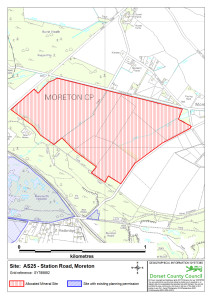Following an approach from a concerned resident of Moreton village in Dorset regarding a proposed policy to allow the quarrying of sand and gravel on a site along the main road into the village from the west – a little over half a mile from the cemetery where T. E. Lawrence is buried – the Society has made a representation to Dorset County Council in opposition to the plan.
The proposal for the 58.5 hectare site on Station Road, Moreton, forms part of the Dorset County Council Draft Mineral Sites Plan July 2015, which may be viewed by clicking here.
Further details including a map can be found at Appendix A: Site Allocations (site AS-25)
Anyone wishing to make a personal representation may do so until 5pm on 23 September 2015. Go to Appendix A: Site Allocations, then use the Add Comments link next to site AS-25.
A petition against the proposal has also been started here.
Below is the statement which has been made on behalf of the Society by the Vice-Chair Alan Payne.
I am writing on behalf of the T. E. Lawrence Society as Vice Chair (I am also a Planning Consultant). Our case is quite simple: the village of Moreton is an oasis set in a part of Dorset which has been adversely affected by mineral working, housing development and by the nearby military training area. The village is of international importance as the final resting place of T. E. Lawrence (Lawrence of Arabia).
He is buried in the tranquil cemetery near to St Nicholas Church, which was where his funeral took place in May 1935 in the presence of Winston Churchill and other dignitaries. In addition, the Moreton tea rooms and the picturesque ford also provide a focus for the thousands of people who visit Moreton. The approach to Moreton from the west is wholly rural and is part of the whole experience of any visit to the village.
The proposed quarry will not only destroy what is the main approach to the village, but the noise of quarrying and heavy lorries will undoubtedly be heard in the village. The National Planning Policy Framework makes it quite clear that as regards mineral workings, local authorities should “set out environmental criteria, in line with the policies in this Framework, against which planning applications will be assessed so as to ensure that permitted operations do not have unacceptable adverse impacts on the natural and historic environment….”.
The Society would strongly suggest that the historic value – as well as the natural environment – have been forgotten in this proposed allocation. What is now being proposed is a development which will adversely affect the final resting place of one of the most important figures of the 20th Century and a valued destination for thousands of visitors, who also make a contribution to the local economy!
Alan Payne MPhil DipTP FRTPI

